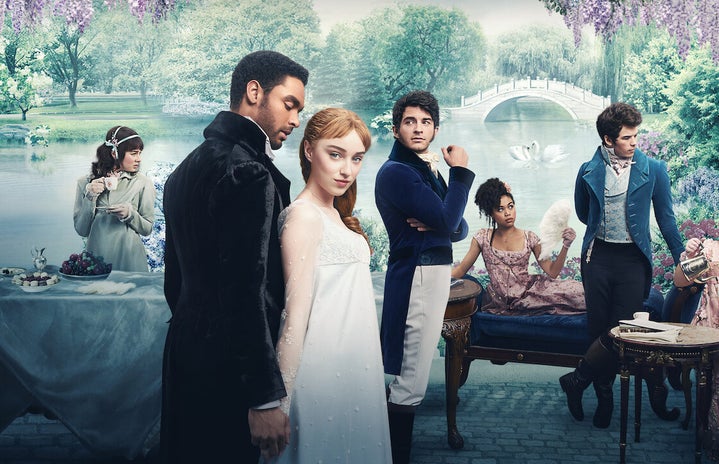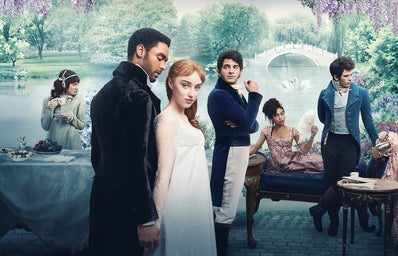Dearest gentle reader, it has been said that the coming of a second season of the much acclaimed Shonda Rhimes produced show, ‘Bridgerton,’ shall bring with it a renewed vigor for rakes, romance, and all things Recency. I digress, I made a point to examine the source material for the show– a series of novels from Julia Quinn– in preparation for the new season. Indeed, I have managed to pore through every single Bridgerton novel, sequel, prequel, and spinoff published to date. Now I can conclusively say that while it is nothing short of scandalous, the episodes centered around the Viscount Anthony Bridgerton are utterly lackluster. Nearly nine hours of my life wasted on binging the show from start to finish the minute new content appeared at 3am on Netflix. As a product of my dedication to the craft and sitting through multiple, grueling hours of this drivel, I can present to you an episode by episode critique. Containing in these pages you will find this author’s exacting eye has caught plot discrepancies, character assassination, and historical inaccuracies alike (with spoilers, sorry).
Before diving into each respective episode, I feel it is important to note that Bridgerton carefully toes a line between being a fascinating, color-blind alternative history and this strange woke fantasy that desperately fails to make any valid critique. There’s no denying that the sparkly brand of colorful escapism Bridgerton presents could have been a nuanced examination of gender roles and social dynamics of the Regency era using a fun Gossip Girl-esque delivery. The pitfalls of the show lie in the fact that they want to have their cake and eat it too. According to the cannon, yes a BIPOC upper class has been around for years, but somehow every iota of stigma was erased when the BIPOC queen married into the royal family. If we simply look at race relations in the U.S., it is evident that a few decades of social turnover is not nearly long enough to rectify longstanding structural inequality. Bridgeton has all the potential to be a fun show with many opportunities for diversity, if not a historically accurate show, without trying to be a liberal think piece. A part of me fears for how future leads will fare if the trend continues of casting a BIPOC actor as the love interest for the season’s respective Bridgerton sibling. If I were to expand upon every single issue with the virtue signaling and performative diversity in ‘Bridgerton’ we would be here till the next season aired. Not to mention there are multiple people who have addressed this topic with far more eloquence, nuance, and background than I myself have. Now let’s get into it! Expect major spoilers ahead.
Episode 1, entitled “Capital R Rake”, is the second longest episode this season at 70 minutes long. Right off the bat, the showrunners deemed it necessary to remind you that this is a Shondaland production, produced by Shonda Rhimes, with all the drama and flair standard of Shondaland shows. Ironic, considering Rhimes was not as enthusiastic about plastering her name everywhere before ‘Bridgerton’ became the biggest quarantine binge of 2020.
This season begins much in the same way the last did, with the presentation of the newly minted debutantes, including the headstrong, thirdwave-feminist-mouthpiece, Eloise Bridgerton. Yes, we get it; you’re not like other girls. Bashing femininity and other women doesn’t just make you a jerk; it also shows off all your internalized misogyny. The fact that the debutantes are usually 17 or 18 years old does concern me a little bit, especially when considering our main lead Anthony is supposedly 29 years old.
The title card features a beautifully animated sequence of close-ups of the all too familiar tree. For fans of the books, they included an overlay of Lady Whistledown’s society papers, the metal hoops for the game of Pall Mall, Anthony’s pocket watch (a treasured keepsake from his late father), and a bee. Other designs on the tree allude to the new characters and later moments in the season, such as a mango design found in henna and a lot of embroidered Indian clothing.
I must say, they give a lot more credence to Anthony’s rakish tendencies, and make his reputation as the overworked head of family and the type to get around town, far more believable. The show introduces the main female lead, re-dubbed Kate Sharma rather than Kate Sheffield as in the book, by having her compete with Anthony in a horse race as he makes his way home from one of his nightly conquests. While the Kate in the novel is incredibly witty, stubborn, and disillusioned with the marriage market– she still plays within the rules Recency society, even if she tends to bend them to meet her own goals. By introducing Kate Sharma, unchaperoned and engaging in a typically male-coded activity, the writers are clearly attempting to double down on the fact that she is the type to march to the beat of her own drums. The writers tend to push this to the extreme, to the point where Kate’s inherent need to be contrarian paints her a somewhat arrogant in her need to always be right, and this makes her somewhat unlikeable in her next interaction with established characters.
Kate meets Lady Danbury with her half-sister, Edwina Sharma, and her step-mother Lady Mary Sharma. Edwina is a breath of fresh air, and is far cry from the pretty lamp post of a plot device she was in the book. Edwina has a personality, and the actress Charithra Chandran delivers the easygoing nature of the character, while imbuing her with a hint of youthful mischief the book failed to deliver. The show hints at a fraught history between Lady Danbury and Lady Mary which caused the latter to spend so many years in India.
There is an extended sequence of the Featherington family drama, which becomes a frightening regularity over the course of season two. The B-plot of this season centers around the new head of the Featherington family following the demise of Penelope’s father. If I’m being perfectly honest, they should have cut any scene with the extended Featherington family out entirely. The only one of relevance is Penelope, but even she barely has enough of a character arc to merit interest.
Finally, we reach the night of the first ball. The costumes have marginally improved, and the dresses now appropriately fit around the bust for the actresses in eveningwear. At least for the standard Regency era A-line gown. The queen is still in rather anachronistic ballgowns and powdered wigs, which would make more sense of Marie Antoinette then on Queen Charlotte. Lady Mary is snubbed by the queen, and most of the other high society mamas, for marrying a clerk and absconding to India without notifying the queen. Oh the scandal, and with an underlying tone of racism. At this point in history, India was still a colony of the British empire being extorted for resources. Gotta appreciate the irony of the show being set in an era of riches and excess plundered from other parts of the world, and then centering the story on a woman from one of the aforementioned colonies who is somehow also a member of high society. This is further compounded by the big secret of the main plot: Edwina’s grandparents, that is Lady Mary’s parents, will provide a sizeable dowry if she marries an English nobleman. Though this should be no trouble for the diamond of this season. Except Kate overhears Anthony being a raging misogynist, listing off his demands for a bride like he’s shopping for a prized cow. They argue, setting up their main conflict for the course of the season: Anthony wishing to marry her half-sister and Kate being vehemently against it.
While I understand the changing of various details for consistency with the first season, a few key details of Anthony’s story are glossed over and thus lead to a lack of depth in the character and the overall tension between the romantic leads. Anthony’s clear disdain for romance can be attributed to his failed raking (there’s a lesson somewhere in there about not falling for your friend with benefits), but his urgency to marry in the novel is related to this impending sense of doom he feels. The man psyched himself out and managed to convince himself he was going to die by 30 years old like his father, and he needed to marry and continue to Bridgerton legacy.
I really like the decision to make Kate a Sharma instead of a Sheffield. The decision to cast a dark-skinned, Tamil-British actress was brilliant. I’m over the moon that the casting directors chose to represent women that Bollywood and most mainstream media do not. Seeing melanated Indian actresses on a big-budget, mainstream, historical television production was huge for me as an Indian woman. However, while I hold a great deal of respect for the actresses themselves, I feel like the show itself was slightly lacking in terms of cultural competency. Had they done just a bit more research, this would have been the representation these actresses deserved. However, take this with a grain of salt as this is a small personal gripe I had when watching.
India is very diverse linguistically and while I don’t have the discerning ear of say my parent’s or grandparent’s generation, for a lot of diaspora Indians it is easy to pinpoint where someone might be from in India purely based on their last name. Sharma, for example, is a much more common last name in northern regions of the country. When we are first introduced to Kate, the audience hears her make an exasperated exclamation in a foreign language. To me at least, it sounded like she said a common Hindi phrase. I assumed they were going to be north Indian characters, especially after it was noted Edwina could speak Marathi and a mix of Hindi and Urdu known as Hindustani. Them being Marathi makes sense. Edwina calls Kate ‘Didi’ or older sister. But they call their father ‘Appa’…a word from the south Indian language Tamil. I didn’t quite understand the interchangeable use of north and south Indian words, but I’m sure deep down there is a good explanation for it. Maybe Kate and her father were the rare south Indian Sharmas, allowing for Edwina to be exposed to her half-sister and father’s linguistic roots while still being more comfortable in her mother’s native tongue. Though I doubt the writers have put as much thought into this discrepancy.
Overall, this was a relatively slow start to the second season. It dragged a fair bit, probably because it was bloated with the amount of side-plots it attempted to cover while rehashing details from the previous season. I had high hopes for the following episodes, but let’s just say as another spoiler it just goes downhill from here.


